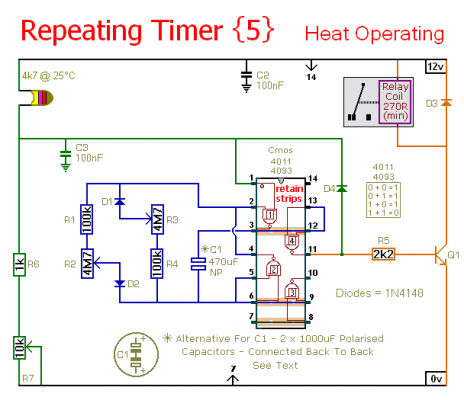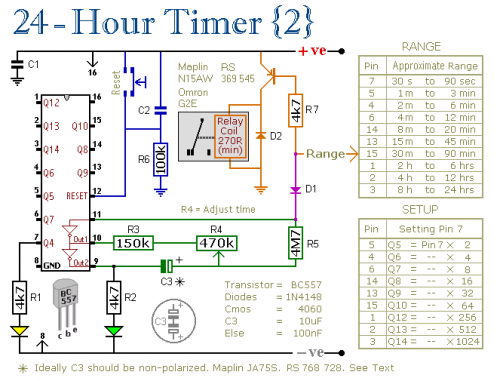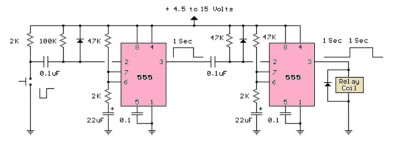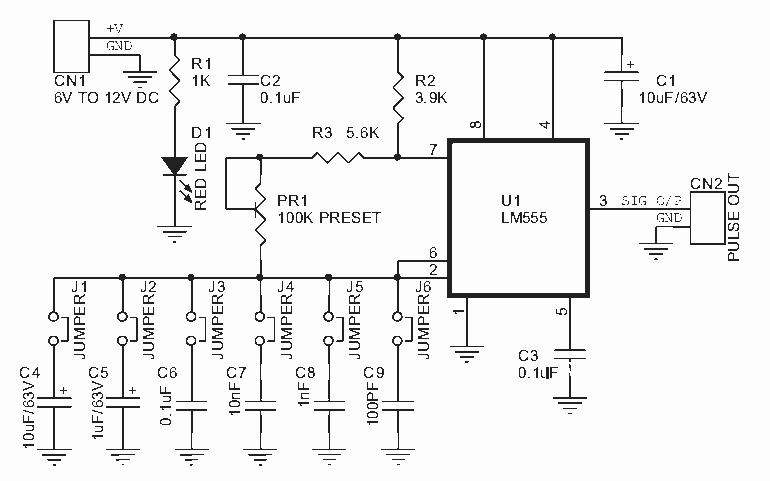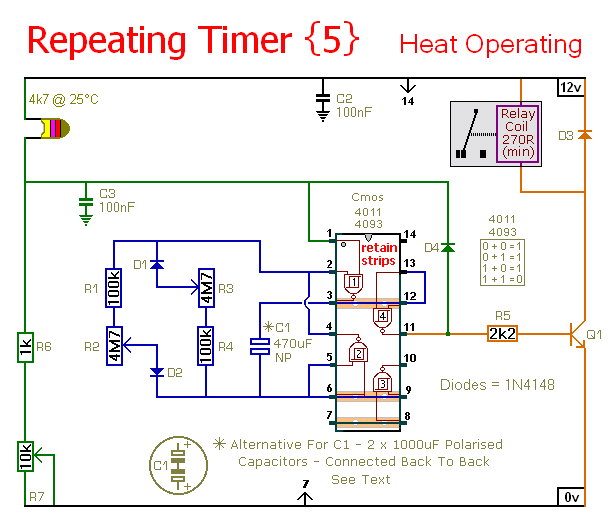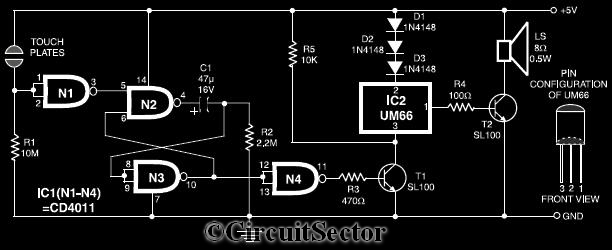
Reaction Timer
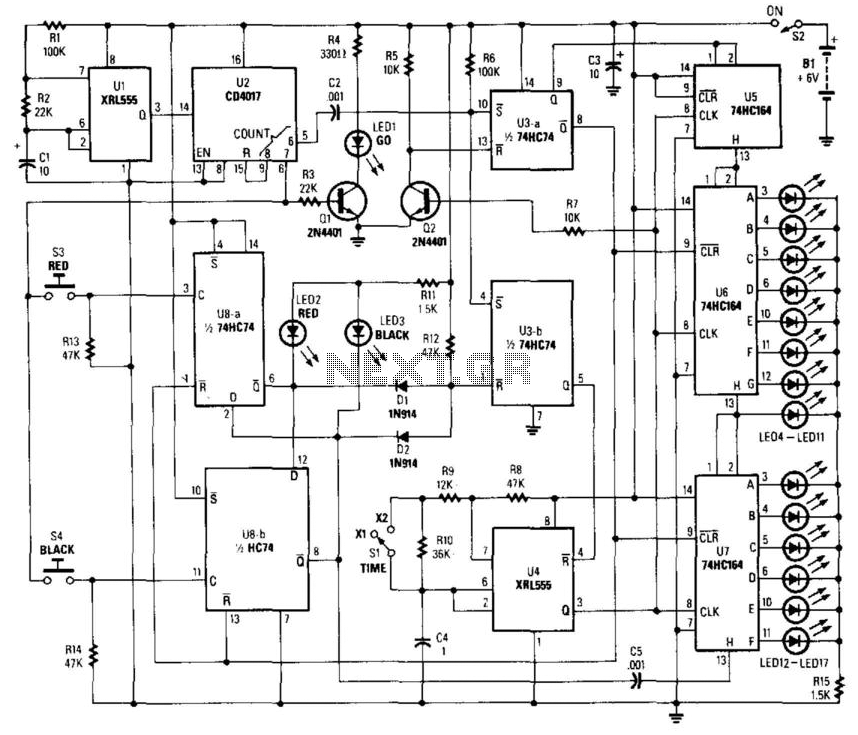
This circuit utilizes a timer to produce pulses at a 5-ms clock rate. The pulses are sequentially shifted into a shift register, illuminating an LED. An auxiliary timer generates one pulse per second to activate the "go" LED and initiate the 5-ms pulse clocking into the registers. Upon receiving the go signal, each player presses their respective buttons (S3 or S4). The delay, or reaction time, is displayed on LEDs 4 to 17; the sequence repeats after six seconds.
The circuit design incorporates a primary timer configured to generate a series of pulses at a frequency of 200 Hz (5 ms period). This timer is crucial for controlling the timing of the pulse outputs that are fed into a shift register. The shift register is responsible for capturing these pulses and subsequently driving an LED display, where each pulse corresponds to a state change in the LEDs.
An auxiliary timer functions independently to produce a pulse every second, which serves to activate a "go" LED. This LED signals the players to prepare for the reaction test. When the go signal is indicated, players are prompted to press their designated buttons (S3 for player one and S4 for player two). The circuit is designed to measure the time taken for each player to react and press their button after the go signal is activated.
The reaction time is quantified by monitoring the duration from the activation of the go signal until the button press occurs. This time value is then represented visually on a series of LEDs ranging from LED 4 to LED 17. Each LED corresponds to a specific range of reaction times, allowing for a quick visual assessment of performance.
After a duration of six seconds, the entire sequence resets, readying the circuit for another round of play. This cyclical operation enables continuous interaction, making the circuit suitable for competitive environments. Overall, the design effectively combines timing mechanisms and visual feedback to create an engaging user experience. This circuit uses a timer to generate pulses at a 5-ms clock rate. The pulses are shifted into the shift register, one at a time, lighting an LED. An auxiliary timer that generates one pulse per second is used to generate timing to activate the "go" LED and start the 5 ms pulses clocking into the registers. At the go signal each player presses his buttons (S3 or S4). The delay (reaction time) is read out on LED 4 to LED 17; after six seconds, the sequence repeats. 🔗 External reference
The circuit design incorporates a primary timer configured to generate a series of pulses at a frequency of 200 Hz (5 ms period). This timer is crucial for controlling the timing of the pulse outputs that are fed into a shift register. The shift register is responsible for capturing these pulses and subsequently driving an LED display, where each pulse corresponds to a state change in the LEDs.
An auxiliary timer functions independently to produce a pulse every second, which serves to activate a "go" LED. This LED signals the players to prepare for the reaction test. When the go signal is indicated, players are prompted to press their designated buttons (S3 for player one and S4 for player two). The circuit is designed to measure the time taken for each player to react and press their button after the go signal is activated.
The reaction time is quantified by monitoring the duration from the activation of the go signal until the button press occurs. This time value is then represented visually on a series of LEDs ranging from LED 4 to LED 17. Each LED corresponds to a specific range of reaction times, allowing for a quick visual assessment of performance.
After a duration of six seconds, the entire sequence resets, readying the circuit for another round of play. This cyclical operation enables continuous interaction, making the circuit suitable for competitive environments. Overall, the design effectively combines timing mechanisms and visual feedback to create an engaging user experience. This circuit uses a timer to generate pulses at a 5-ms clock rate. The pulses are shifted into the shift register, one at a time, lighting an LED. An auxiliary timer that generates one pulse per second is used to generate timing to activate the "go" LED and start the 5 ms pulses clocking into the registers. At the go signal each player presses his buttons (S3 or S4). The delay (reaction time) is read out on LED 4 to LED 17; after six seconds, the sequence repeats. 🔗 External reference
Warning: include(partials/cookie-banner.php): Failed to open stream: Permission denied in /var/www/html/nextgr/view-circuit.php on line 713
Warning: include(): Failed opening 'partials/cookie-banner.php' for inclusion (include_path='.:/usr/share/php') in /var/www/html/nextgr/view-circuit.php on line 713
